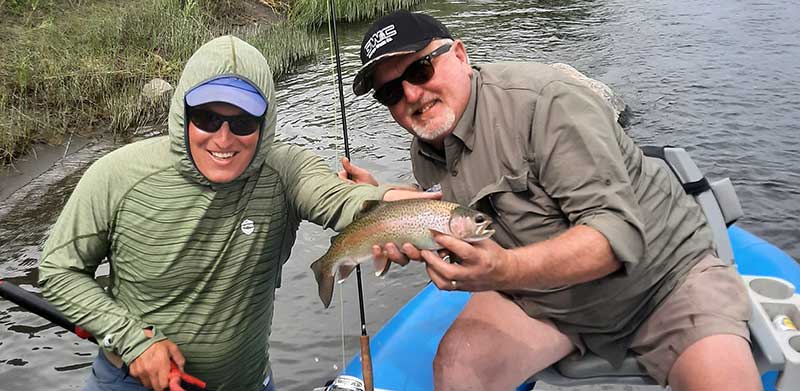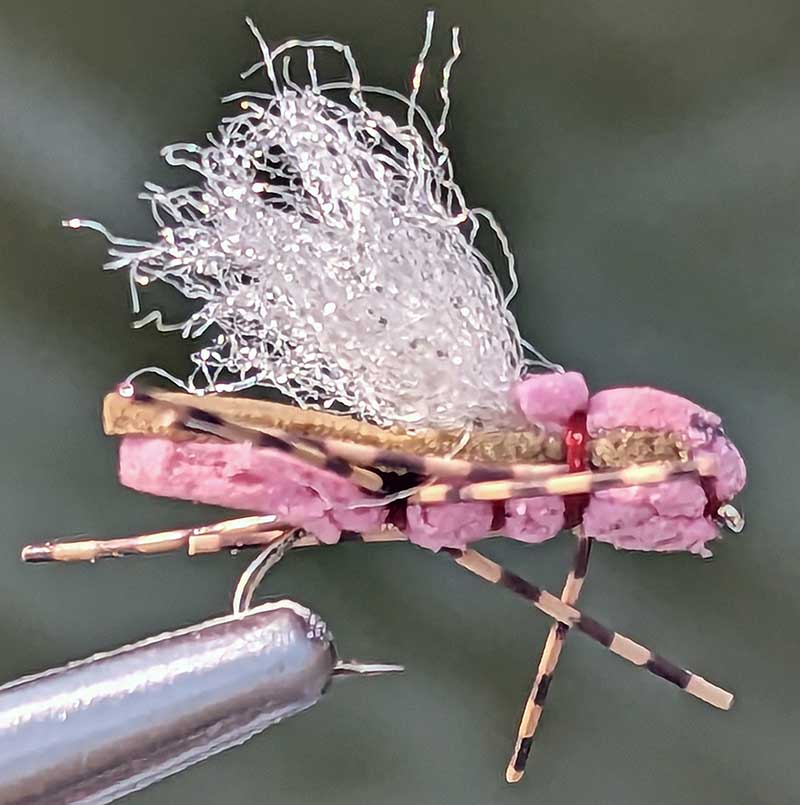Late Summer Float Trips
Posted on January 23rd, 2024 in Uncategorized

Late summer is a prime period for larger trout on dry flies. This one (like most) ate a grasshopper imitation in fast water.
Late Summer Float Trips: Introduction
Late summer begins when rivers drop from the edges of the bushes and get slower. In the meantime, rivers turn crystal clear rather than green and aquatic insect hatches diminish, but terrestrial insects such as grasshoppers and ants begin blowing into the water in greater and greater numbers.
Some rivers get too low and in some cases too warm, but others become less challenging to fish, particularly in terms of the accuracy of casts required. While not quite so consistent as early summer, this period often offers easier fishing from a technical standpoint, and certainly offers slower-paced fishing, since flows are now low and slow enough to pick targets apart rather than blowing by.
For anglers who want to target larger fish on dry flies, as well as numbers on dries and small nymphs, this is a great period.

Late summer sees excellent cutthroat trout fishing with dry flies.
Late Summer Float Trips: Quick Facts
- Best Waters: The Yellowstone and Stillwater are by far the best rivers in our operations area at this time, and the two on which we do the vast majority of our guiding. The upper Missouri between Three Forks and Townsend can also be very good, though the quarry there are mostly carp rather than trout.
- Three Top Reasons to Come in Late Summer: 1.) The terrestrial dry fly fishing is great 2.) The fishing if not necessarily the catching is easier at this time than earlier in the summer, and 3.) Larger fish (on average) are more interested in dry flies than they were earlier.
- Three Top Reasons to Avoid Late Summer: 1.) During dry years, late summer is when we have fishing restrictions due to warm water temperatures and the greatest potential for forest fires, 2.) Crowds are still high, and 3.) “Match-the-hatch” fishing is limited.
- Perfect Clients: Clients who love dry fly fishing, but prefer the slightly slower pace the lower water present during this period gives to trips.
- What Late Summer Does Best: Late summer generally produces excellent dry/dropper fishing for fish that average a bit bigger than they do earlier in the summer, albeit with less consistency of weather and water conditions and therefore less consistent fishing.
Late Summer Float Trips: The Details
As the rivers drop, clear, and warm, and as aquatic insect hatches begin to decline, conditions transition into what we consider “late summer.” This is a gradual change and isn’t clear-cut. This period begins sometime in late July or early August, depending on the previous winter’s snowpack, how this snow melts, and summer weather.
The fishing during this period is similar to early summer, but it’s a little less frenetic, a little easier for beginners in terms of technique, and the fish start getting a touch spookier. While the fishing is a little harder overall than it is earlier in the summer, it remains quite good unless water temperatures get too high, and the slower pace of the fishing coupled with the better chances of big fish on dry flies make this another favorite period for many of our clients, and many visiting anglers in general.

There are two key drivers to the float fishing at this time: terrestrial insects and water conditions.
The terrestrial insects, mostly meaning ants and grasshoppers, are usually the most important dry flies in late summer and are a lot of fun for most anglers to fish. The big numbers of fish usually come on ants (or occasionally small aquatic insects or nymphs), while the big trout tend to come on the larger grasshoppers.
The fish aren’t quite as eager to wallop dries at this time as they are a few weeks earlier, so anglers need to up their game a bit for success, but when anglers get it right, this is often the time that produces the most action on dries, simply because the fishing is a bit slower-paced than earlier in the summer and so it’s easier to hit more of the holding water.

Grasshoppers often get chewed apart in late summer. Yes, pink is often THE color.
The reason the fishing has a slower pace during this period is streamflow. All rivers drop through the summer. The only question is how much they drop. If they drop too much, especially if the weather is hot and dry, they get too warm. Sometimes this means the afternoon fishing is poor. Sometimes this means that rivers are closed after 2:00PM. These are called “hoot owl” closures, and they’re getting more and more common due to global warming.
Certain rivers within our operations area are now almost always closed for part of late summer, chief among them the lower Madison and the Jefferson, but these are poor choices anyway. The real problems happen when water temperatures begin spiking over 70 degrees on the Yellowstone or Stillwater. It’s unusual for these rivers to endure hoot owl restrictions, but low water and high temperatures do lead to some tough fishing, usually in early-mid August, particularly in shallow areas of Paradise Valley and east of Livingston on the Yellowstone or after 2:00PM on the lower Stillwater.
Because of the potential for water temperature issues in mid-late afternoon, visitors looking to come in late summer must understand the risk of having to start early or cut trips short if temps are too warm. Also note that the Boulder River is never high enough for float trips during this period. This is a tiny river, so once it gets low, even a kayak would have trouble getting down it, much less a fishing raft. For similar fishing as the Boulder provides, the Stillwater River is very good unless it’s too warm.

If water temperatures are okay, as they usually are on our preferred rivers (the Yellowstone and Stillwater), fishing techniques resemble those of early summer: dries, dry/dropper, and “drifting and dragging” streamers. The flies themselves change a bit, since as noted the terrestrials are the hot bugs most of the time. The fish begin moving off the banks somewhat, so we seldom “bang banks” in late summer like we do earlier. Other than these minor changes, anglers who like the sound of early summer will like late summer well, too.
Beginners will like late summer better. Since casts need not be as accurate and the currents are slower, beginners typically do better on late summer river floats than they do in early summer.
Full-day and half-day floats are available at this time. Because of the potential for water temperature problems, it’s conceivable we might need to meet for full-day trips as early as 5:00AM, though this is rare. Unlike early summer, there’s usually little point for half-day trips meeting late in the afternoon. In fact, we’ll usually run half-day trips in the mornings during this period unless we’re in the midst of a cool spell.
>>>>>>>>>>>>>>>> Return to Float Trips Page
